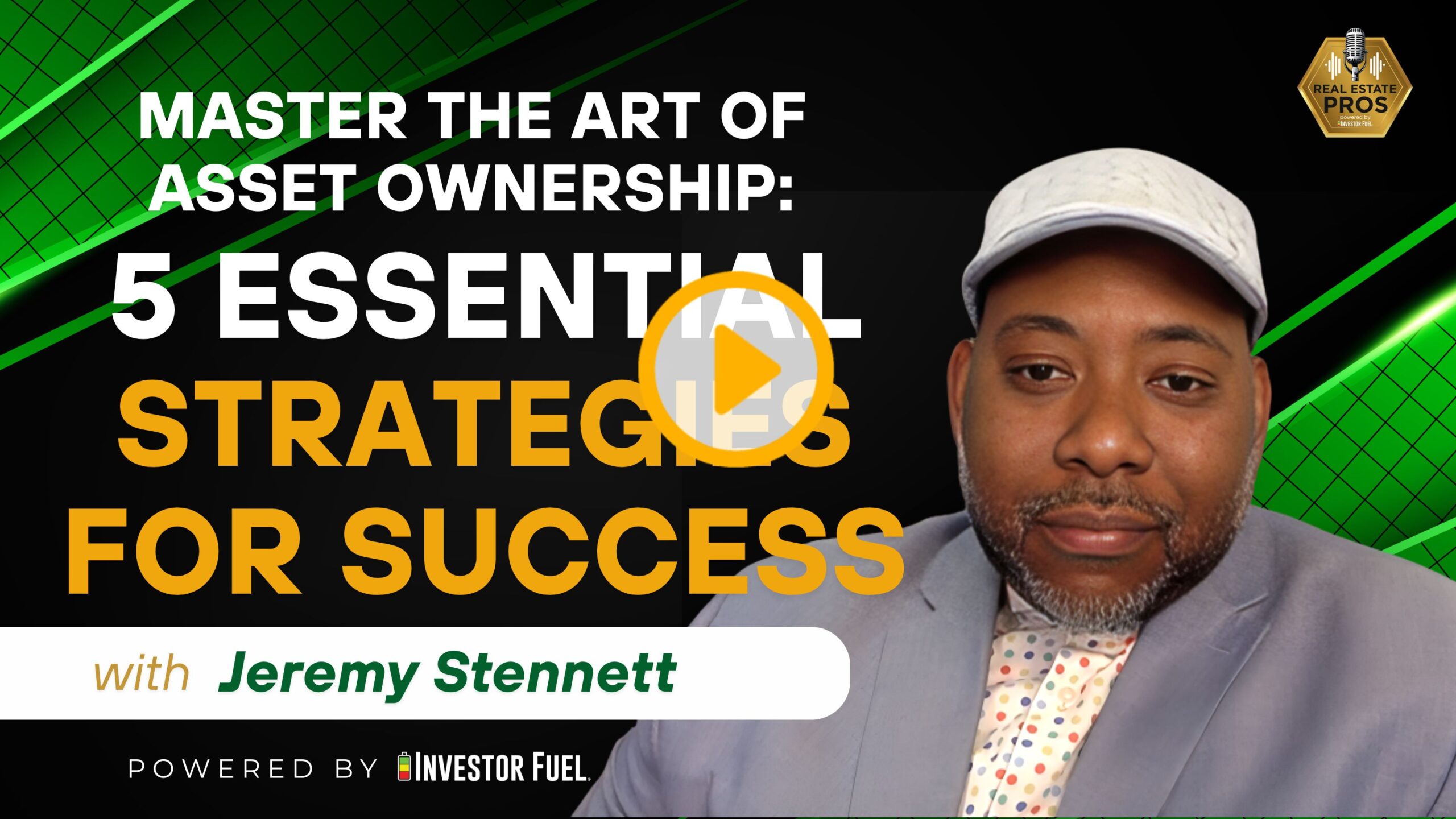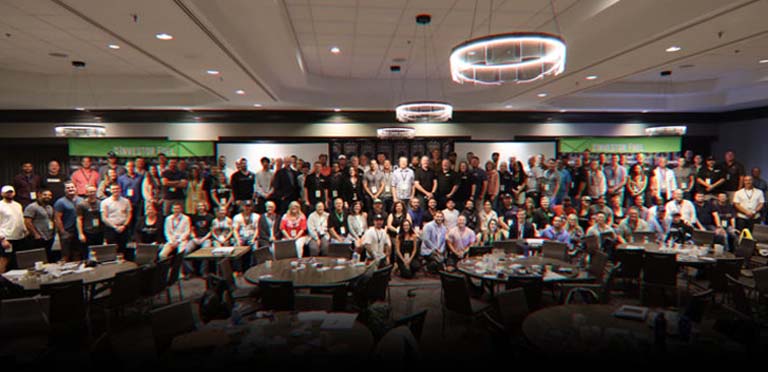
Show Summary
In this conversation, John Harcar and Jeremy Stennett discuss the journey of building wealth through real estate and assets. Jeremy shares his background, experiences in the real estate industry, and the importance of asset ownership for entrepreneurs. He emphasizes the need for mentorship and the value of protecting intellectual property. The discussion also covers strategies for building wealth through licensing and franchising, as well as resources available for aspiring investors.
Resources and Links from this show:
Listen to the Audio Version of this Episode
Investor Fuel Show Transcript:
John Harcar (00:01.262)
All right. Hey guys, welcome back to our show. My name is John Harcar. I’m your host. I’m here today with Jeremy Stennett and what we’re going to talk about today, you know, besides his journey in business and in real estate, we’re going to talk about how, you know, every average day Joe can access wealth through assets. Remember guys, at Investor Fuel, we help real estate investors, service providers, I mean, all real estate entrepreneurs, to 5X their business by providing tools and resources to grow.
that business that you’ve always wanted to live the life you’ve always dreamed of. So Jeremy, welcome to our show.
JEREMY STENNETT (00:36.036)
My man, thank you so much, John. I really appreciate the opportunity to share.
John Harcar (00:39.51)
Yeah, I mean, looking forward to talking about our topic of building wealth through assets, being in real estate. That’s kind of what we’re looking to do. But before we kind of get into the weeds and talk about all that, why don’t you give our audience a little background on you, kind of where you came from, how you got here, what got you into real estate, all that good stuff.
JEREMY STENNETT (00:58.104)
Yeah, absolutely. Like I said, thank you for having me on. I grew up in upstate New York, right? I’m actually from, originally from Jamaica, but I came to New York in the nineties, right? And the early nineties where, you know, I think, I feel like America was an interesting place around that time, right? I grew up in church, regular community, Poughkeepsie, right? We call Poughkeepsie the other capital or the first capital of New York, right? And so.
John Harcar (01:24.353)
Why is that?
JEREMY STENNETT (01:25.794)
Well, the Metro North stops there. Metro North brings everybody from upstate to Manhattan, to the boroughs. It’s like the hub of, upstate hub. A lot of things happen in that Hudson Valley area. All the wineries are there, lots of breaks. The center of New York State to us is the hub. So we think of it that way. But growing up in a community that’s
John Harcar (01:31.189)
Okay.
The HUB, okay?
John Harcar (01:42.071)
Hmm
John Harcar (01:49.688)
Got it. Okay, cool.
JEREMY STENNETT (01:55.234)
very diverse. When you think of Poughkeepsie, you can think of New York City. It’s a very diverse city. It has its own economic challenges, the what you call rich, medium, and poor communities. And I grew up in church, and my church was interesting because I like to say to people, we never actually did a bake sale or a fundraiser. A lot of times people go to church and they’re trying to raise money for all kinds of things.
And what that did for me at an early age, it gave me access to see money differently. You know, and so growing up, we were doing lots of community oriented things like figuring out how to provide housing, figuring out how to create jobs in our communities for those that need access and support. And so when I went to college for advertising, it just was a natural mindset for me to start looking at how businesses run and how it works. Right? Got laid off a little bit.
John Harcar (02:48.621)
Right.
JEREMY STENNETT (02:51.178)
in the early 2000s and got a job in a wholesale lender. And so I believe, you know, that was kind like my entree into understanding the mortgage industry or the real estate industry from the lender’s perspective, right? But not just from a retail perspective, but from a wholesale lender. How does a wholesale bank make money? And so it really gave me a chance. So think about like, Guy, coming from the community where, you your church had
John Harcar (03:07.576)
Got it.
JEREMY STENNETT (03:19.812)
lots of liquid assets, had a desire to help people who didn’t have access to homes or didn’t think they could, right? So now going into corporate America, working in advertising industries, like if you Google me, you’ll find like, name tied to brands like, it’s okay to say brands, know, tying all the big brands, that gives me a perspective on small and then global. You know what I’m saying? And then now getting a job in a mortgage industry that
John Harcar (03:37.923)
Sure.
JEREMY STENNETT (03:48.63)
on the wholesale side, what that means is for those who may not know what a wholesale lender is, you’re working with brokers, you’re working with lenders and they’re lending from a line of credit. That meant that you give those secondary lenders, those other people who may not have a chance to get access to property, a chance to get access to property, right? know, some people blamed the crash on those secondary tiers back in 08, but I would like to think that
John Harcar (04:07.574)
Mm-hmm. Right, right.
JEREMY STENNETT (04:17.132)
it gave access and it opened up more opportunities, right? And the history of America or the history of the world shows that there’s patterns and waves, right? And so you can’t blame any one group for a country’s challenges. It’s just a part of process. And when those dips happen, then it gives opportunity to them, to some, and then challenges to others. So fast forwarding from that job, what that really did for me was it gave me the perspective.
John Harcar (04:20.824)
Right.
JEREMY STENNETT (04:45.956)
So then I dove into, after I left there, I was still passionate about advertising. So I dove into how I can be a broker while doing advertising. And I got a job as a brand manager for a family-owned company, Upstate New York. And what was great about them, what they were doing, and their perspective on real estate was as they were growing their business, they would go around buying small mom and pop. They were a home center.
John Harcar (05:10.904)
Okay.
JEREMY STENNETT (05:11.684)
and they would buy small mom and pop businesses and put their names on it. So I was an advertising director there and I’m like, you know, I mean, in my twenties, you’re not realizing what you’re absorbing, right? You’re doing your job and you’re moving along. know, 10 years later, after I left there, opened my own firm, ran my own advertising agency for about 60 years, started to learn business, learn about how to get credit, how to operate, to, know, what a day-to-day business person is supposed to do.
John Harcar (05:21.548)
Right, right.
John Harcar (05:41.091)
Sure.
JEREMY STENNETT (05:41.868)
I’m the first in the family with a bachelor’s degree, so it’s a challenge. There was no mentorship. There was nobody to give me that guidance and to, son, do this or do that, right? Today we learned the value of a mentor. I just felt like along the way, each of these steps was bringing me to where we ended up today, where as I’m running this advertising agency, I’m learning about business, I’m realizing, wow, I need to own some physical assets in order to survive as a business owner.
John Harcar (06:11.406)
Mm-hmm.
JEREMY STENNETT (06:11.972)
because the last, if there’s a phrase we talk about in advertising, you’re only as good as the last good deal you did, right? So as I’m working and trying to figure it out, I was like, I got some understanding on how to do wholesale lending as a broker. Let me find an investment property and try my hand at that. So in my 20s, I got started in real estate personally, buying my first duplex with, and back then,
John Harcar (06:17.141)
Right, right.
JEREMY STENNETT (06:39.512)
This was when you could do the 100 % financing. don’t know if you remember those 80, 20 loans. So I was able to buy my first duplex and really didn’t understand the whole FHA program. It was literally fine yet because it was 100%. You had good credit. You could do a stated loan, did a stated loan, got my property, was fully rented. But because I didn’t have mentorship, right? I didn’t know one thing about being on the house. So.
John Harcar (06:43.767)
Yep.
John Harcar (06:54.872)
Mm-hmm. Yep.
John Harcar (07:04.268)
Hehehehehe
JEREMY STENNETT (07:06.829)
The traditional growing pains of every person who’s taken that, you know, that journey happened to me, right?
John Harcar (07:13.742)
So what did you do? mean, you got this, you bought a four-plex and now you’re just kind of like, what did you seek out? What did you, who did you seek out?
JEREMY STENNETT (07:21.028)
At that time, didn’t really, I thought I was good. I thought I knew what I was doing. My family was very supportive, but we didn’t really, my mom owned a house, but we didn’t really know how to be a landlord. We just knew how to take care of our own. I used to work, remember that company I worked for as a brand manager. So I would go and get all my home supplies and I thought that I had a connection there. But then I had to learn that tenants would destroy the property and you need to fix it. Sometimes people hear about those Section 8,
you know, online ads. I had some Section 8 tenants. And then because it was 100 % financing, there was like, my cushion, my margin for like cashflow, today I know what that is, was 200 bucks. So, you know, it was like, yeah, man, my net was 200 bucks. So what happens if somebody didn’t pay rent for that one month, right? I’m like in trouble. But in 20s, you’re not thinking about that, right?
John Harcar (08:03.79)
For the hole for the for the duplex?
John Harcar (08:16.728)
Yeah.
JEREMY STENNETT (08:19.576)
You know, you’re thinking, I got a property, I got rent, it’s coming and I’m gonna be rich. I’m gonna get, you know, it’s gonna have equity. It’s gonna be great. Fast forward, it turned into a disaster, man. Like tenants weren’t paying or the section eight people would hold your check because the tenant didn’t do something or the tenant would report something because they wanted something, whatever the reason was. And eventually, you know how that deal ended up? A short sale, right? Because now,
John Harcar (08:19.63)
No, you’re not.
John Harcar (08:39.106)
Mm-hmm.
John Harcar (08:44.662)
Yeah, I was going to try to say foreclosure, but I didn’t want to say that. Sure.
JEREMY STENNETT (08:48.93)
Now, it’s your sale. But I think I learned a lot along the way, right? Got my experience. that way, my next time I went into a transaction, now I knew how, what not to do. Here’s what I would say to people now, today. So between then and now, I ran an advertising agency. I learned how to, what my employers were doing when they were building companies and buying physical structures and…
John Harcar (09:14.082)
Mm-hmm.
JEREMY STENNETT (09:17.828)
you know, so that they own the asset. And then I started helping clients. So as I’m helping clients in advertising, I started to do what my former employer would do. Hey, you own a pizza shop, I’m helping you marketing, you know, you should think about buying the building you’re in or finding a building that you can buy and let’s pivot to the asset piece and license your location, your business model, and let someone else actually.
John Harcar (09:38.883)
Yeah.
JEREMY STENNETT (09:45.336)
pay you to use that business model that you’ve been so successful with. So now I’m teaching my clients how to own their, protect their IP, meaning their intellectual property for their business, but also buy the structure for the location, buy the building that the location that their future franchisee was going to operate from. Right? So that’s how I started really kind of starting understanding, wait a minute, I found a niche that I can really be helpful to that regular entrepreneur.
John Harcar (09:48.312)
Mm-hmm.
John Harcar (10:04.29)
Mmm. Got it.
JEREMY STENNETT (10:15.19)
Right? I know where they came from because I felt my own growing pains alone, you know, in my own experiences, but also got successful examples of the people that I used to work for as a marketer and a strategist. I figured out, wait a minute, that guy who was running the pizza shop, the restaurant, the takeout restaurant, that’s what runs, you know, in New York City, they these ads that says small business runs the city. Well, small business runs America, right?
John Harcar (10:15.222)
Right, right, right, right.
John Harcar (10:29.496)
Mm-hmm.
John Harcar (10:42.349)
Right.
JEREMY STENNETT (10:43.918)
They’re the ones who are hiring the local people. They’re the ones who are doing their best to keep things going. And that’s the group that I figured they need to help the most. Think about it. They’re the ones that need the loans. And most of the time, entrepreneurs, they don’t have enough leverage, that they use, sometimes they’re using their credit cards to do payroll. I’ve done it, right? know, most people have. I think all those billionaires on Shark Tank have shared their stories of
John Harcar (11:04.792)
Right.
JEREMY STENNETT (11:13.078)
of doing that, right? They’ve talked about their journey. So when you’re an entrepreneur, you’re doing okay in business, but you need some cash for whatever reason, buying new equipment, whatever the reason is. Get a car for yourself, right? Life things, you might need cash. What I’ve found, and I’ve given tips to clients is, hey, you could actually create your cash.
John Harcar (11:14.338)
Mm-hmm.
John Harcar (11:27.361)
Hmm.
JEREMY STENNETT (11:41.806)
So instead of you trying to get what they call an MCA loan, is Merchant Cash Advance Loan, which really, you know, I just got a letter from one of the attorney generals that said that they’re really drilling down on those companies because they’re predatory. They’re really, you know, they’re hard for those companies who are trying their best. And it seems easy to get that money, but then it becomes, you didn’t anticipate how much of a drain it was going to be on your cash flow, right? And so now there’s some challenges, but imagine if you have a successful pizza business or a successful
John Harcar (11:54.839)
Yeah.
JEREMY STENNETT (12:11.096)
take out whatever kind of food business or a clothing store that’s doing well, whatever the brand is, juice bar. I you can just literally walk down coffee shop, right? Come on. In every corner in every city in America, there’s five different coffee shops on every corner. Yes or no? Right? So, I literally, I’m down here on Wall Street and in a one block square, there’s five different coffee shops. Joe DeJuice, this one, Starbucks.
and they’re all there, but they have like five or six locations. Somebody figured out that they could actually do two things. Yes, open multiple locations, but the secret to that is, when it comes to asset protection, is two pieces. One, protect the brand name that you created using intellectual property, and then two, when you license that, you get cash. So somebody’s gonna pay you to use your, let’s use Joe to juice or whatever the coffee company is, or you know.
John Harcar (13:08.622)
Uh-huh.
JEREMY STENNETT (13:10.05)
not Starbucks, they had corporate stores for a long time. But a lot of the other companies that franchise their or license their names out, you know, would have those locations. Someone’s going to pay you quarterly or one check, depending on their situation, for the year, five, 10, 15, 20, $100,000 just to use the name. So now you have an asset, right? Because you don’t have to do anything. It brings cash in, and that cash can go to whatever you want, personal or to operate.
John Harcar (13:28.782)
to use the name.
Mm-hmm.
JEREMY STENNETT (13:39.426)
It could be a bonus. It could be anything you need. So now you’re liquid. Okay. So now you can solve that problem you wanted, but here’s the long-term opportunity. So while that’s still long-term, it’s reoccurring, right? It’s only like once a year or whatever that term is. So it doesn’t bring you all the time cashflow, but that new location is going to go in and they’re going to open a next location in order to run that brand that they’re licensing from you. Well, if you took the 20 %
John Harcar (13:43.544)
Yep, yep.
John Harcar (13:56.696)
Right.
JEREMY STENNETT (14:08.036)
right, as an investment property, as a down payment, and get 80 % as a loan, right, you can buy a physical location and rent to that next business, to that business that’s gonna go in there. In most cities, New York City’s included, but most cities where it’s not ridiculous, right, so most people would say, oh, you could say that, but New York City is hard. Well, sure, because they have lots of multimillion dollar buildings. But cities like Albany, Georgia, Dutchess County,
John Harcar (14:20.12)
Yeah.
JEREMY STENNETT (14:36.504)
You know, Charlotte, North Carolina, those buildings are available. Those cities need business owners to open those locations downtown. Cities in Youngstown, Ohio, right? All these regular American cities that there’s lots of opportunity for business to go in and help create locations, rent, create jobs, right? So you take that 20 % from the franchise fee or the licensing fee as your down payment towards that building.
John Harcar (14:52.75)
Mm-hmm.
John Harcar (14:56.674)
Yep. Yep.
JEREMY STENNETT (15:04.866)
And now every single month, that business owner who’s renting from you is going to go ahead and pay you rent. Now you’re looking at a long-term lifestyle that along with your business that you could probably retire or shut down your business, but why do it when you can start focusing on a second business of selling licenses to your brand.
John Harcar (15:12.142)
Mm.
John Harcar (15:25.262)
I love it. love it. So yeah, that’s truly using the assets to go. Yeah, I can see how that will grow the wealth. So how do I mean, how do people learn how to do this type of stuff? Right? I mean, it’s not something that everybody knows. I mean, are there is there resources or tools out there that people can use to learn this?
JEREMY STENNETT (15:41.092)
So by all means, one, it’s a fusion of a few things, right? There’s the real estate game itself, right? Understanding that in simplicity, if you try to simplify investment property, at the end of the day, 20 % or 30 % cash towards a loan or total sales price, and then the investor or banker will lend you the rest of the money. So that’s reasonably standard.
John Harcar (15:50.658)
Right.
JEREMY STENNETT (16:10.294)
If you can look at any business, I mean know it sounds complicated, but to try to simplify it, any food business that’s doing well, that people are coming in and asking you, if you’re a bakery, if you’re a coffee shop, if you’re laundromat, it’s endless as to what the possibilities are. So if your business is truly successful, meaning you’re making sales, you’re paying your bills, but you could use some cash, the first thing you need to do is,
start to ask your most regular customers or people who come in and compliment you, right? Hey, you ever consider opening one of these things? It could be that simple, right? And so sometimes we don’t think of it that way, because we’re so busy in the business, right? Most attorneys these days will give you a complimentary consultation, right? So just ask for a consultation. Most accountants, know, sometimes attorneys and accountants
John Harcar (16:47.32)
Yeah. Yeah.
John Harcar (16:52.27)
Right.
JEREMY STENNETT (17:06.776)
you know, they’re like on opposite poles. But they’ll give you consultations. They’ll give you a few minutes to talk to understand what your needs are before you have to find some money to pay for the service. So you can ask a couple of questions. Hey, what would the process be if I wanted to do that? Now, here’s the key word. You need an intellectual property attorney.
John Harcar (17:26.594)
Intellectual property attorney, okay.
JEREMY STENNETT (17:28.644)
So if you get to an intellectual property attorney, you want to be able to register your trademark for the brand, the business you have. And that attorney, if they’re savvy, will help you to do what they call a trade secret protocol, meaning protect the things that needs to be protected in your business so that it’s valuable. That’s the asset piece. So once you’re able to protect the thing that people won’t know, the secret sauce, there was a client I had in South Florida, it was a bakery.
John Harcar (17:35.832)
Right.
John Harcar (17:49.422)
Got it. Makes sense.
JEREMY STENNETT (17:58.74)
you know, he would like wave his flag of pride that he has the secret formula of gluten meets, you know, his other spices to make this unique hard dough bread, right? That’s his trade secret. the truth is people have tried it and people have copied his name and tried to do the similar thing. So if you find people trying to do the similar things you’re doing, you have something to protect. Okay. So taking those steps,
John Harcar (18:11.214)
Mm-hmm.
John Harcar (18:24.568)
Yes.
JEREMY STENNETT (18:28.292)
by you getting a consultation that’s usually free to start, right? Then on average, a trademark takes you anywhere from about 10 months to about 24 months or so to get completed, right? And a lot of times people say, oh, I do it myself. And I think about 5 to 10 % of people are lucky that they get their trademark applications processed through successfully.
John Harcar (18:33.102)
Mm-hmm.
JEREMY STENNETT (18:56.906)
Many people think it’s an application you submit and then you have a trademark. That’s a common mistake. So that’s important. Get the facts, understand, get a consultation, know what you need. Then it’s just a matter of saying, if there’s someone that needs help. So here’s how that person can find, that can get you that down payment to use your brand. So you can get the 20 % to buy that building, right? Because you’re like, hey, Jeremy, man, you’re telling me to take 20%, how do I even do that?
John Harcar (19:04.302)
Mm-hmm.
John Harcar (19:22.402)
Right, right.
JEREMY STENNETT (19:26.692)
In these days, right, business credit cards, you hear people having conversations about business credit cards or a business line of credit, right? You can get a business credit card and that person, that’s zero APR, and that business owner could then use that as their, towards their down payment. You’re gonna swipe that card, take that down payment, and ta-da, you have 20%. That person now has a business relationship with you to borrow your business concept.
John Harcar (19:49.154)
Yep, there you go.
JEREMY STENNETT (19:56.578)
Right? So it is not an overnight process. Let’s say anywhere from three, yeah, let’s say, you know, anywhere from three months to six months. Here’s the good news. If you take the steps to start protecting your trademark early, you can still start implementing these strategies right away. So it’s not like you have to sit and wait for your trademark to be completed in order for you to start taking these next steps. Right?
John Harcar (20:00.92)
Doesn’t sound like it.
John Harcar (20:21.358)
Got it. Is this something that you teach? I mean, do you have a course here, your business? mean, tell us about that.
JEREMY STENNETT (20:24.682)
Absolutely. Absolutely. so, so what I, you know, and I would have to give away something today. I created a little free, you know, real estate investment guide. that way I can, you know, give some tips away and I’ll be making more of these strategies. Actually I’m working on a book, right? my vision was if, if you can’t afford to pay a consultant, maybe you could buy the book and get the, the, the tips from the book and then try to implement those steps in the book. Okay.
So I’m gonna work on writing a book of ways that people, everyday people can actually, you know, start making wealth with real estate and other assets, right? So that’s my, so you can go to jeremystand.com forward slash free guide and someone can get a real estate guide that that will send them via email. But yeah, I offer free consultations to individuals that may want to have questions so we can understand where they are and show them.
John Harcar (21:03.406)
Okay, cool.
JEREMY STENNETT (21:23.512)
where there’s opportunity in their current business or in their current circumstance. And then that way they’re able to understand what their steps or their options are.
John Harcar (21:28.002)
That’s awesome.
John Harcar (21:33.646)
That’s awesome. Yeah, because I mean, I know this is something that I don’t think a lot of people have heard of, maybe understand or, you know, know the benefits of it, right? Which is really, really cool. I love everything you said. So how do people get ahold of you? I mean, what is the best way?
JEREMY STENNETT (21:48.932)
I’m easy to find. I’m easy to find. JeremyStennett.com and you can click and make an appointment. I’m on all social media under my name, under Jeremy Stennett. And I’m right here in New York City on Wall Street. So if you couldn’t find that, type Google. You can type Jeremy Stennett on Google and find it. But we’re happy to give a complimentary consultation so that you can see what opportunities you have. And then we can figure out how to cover the costs to take the next steps.
John Harcar (22:17.486)
That’s awesome guys. I hope you guys took some notes. I mean, there was a lot of stuff to take notes on man. Jeremy, thank you for sharing all that. That was a lot of stuff. I don’t even I didn’t even know about which if you look at it all makes sense, right being able to use the assets for your wealth and build that way. That’s tremendous. thank you again for coming on guys. I hope you enjoyed the show and we’ll look forward to see on the next one. Cheers.
JEREMY STENNETT (22:40.578)
Yeah, you’re welcome. Thank you so much. Bye bye.






